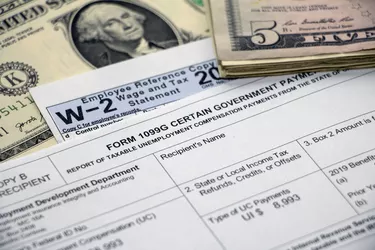
It's difficult to calculate your annual salary using a W-2 if you also receive any benefits, commissions or bonuses. "Salary" is different from "income" or "compensation," which might include a set salary, and then additional monies, such as bonuses, an employer 401(k) contribution or health insurance.
You obviously know what you agreed to work for when you were hired, but you might want to confirm you were paid that amount, and using your W-2 will help you confirm that, depending on your income situation. If you only worked part of a year, you can use your W-2 to see if your earnings would have added up to your agreed-upon salary.
Video of the Day
Video of the Day
Purpose of a W-2
Among the list of IRS forms, you'll find a W-2 form, which is a record of your wages earned as an employee. It includes the amount of salary, wages, tips, bonuses commissions and other income you earned, as well as the taxes you paid. Some payments you received from an employer, such as expense reimbursements, won't appear on your W-2 because they weren't income you earned, and thus weren't taxed. The tax information on your W-2 shows how much Social Security and Medicare tax you paid on your wages, explains Turbo Tax.
You won't receive a W-2 if you are a contractor, and you will instead receive a 1099 from your clients (if they paid you more than $600 during the year), which is similar to a W-2, but only shows your wages earned.
Confusion With W-2 Forms
You don't pay Social Security tax on all income you earn if you earn more than $142,800 (for 2021). If you earn more than that, the additional income isn't subject to Social Security tax. There is no cap on the Medicare taxes you pay – so that box (Box 6) on your W-2 might be most helpful in determining your annual salary.
If you look at Box 3 of your W-2 form, you will see your total annual income subject to Social Security tax. This means the amount of annual income reported in Box 3 might be less than your total earnings (if you earned more than $142,800). Make sure not to use this number to try and calculate your annual salary for the year if you make more than the cap.
Other issues with W-2 forms are that they don't include your non-taxable income, and they include income that is not part of your salary. It's all lumped together as annual income on W-2s. For example, if you earn a bonus or commissions, that isn't part of your salary, even though it's part of your income. If you contribute to a 401(k) or health plan, you use part of your income to do that, but that income is then not taxable, further confusing things.
In short, if you earn $60,000 in salary each year, as well as a bonus or commission, and have a variety of benefits, there's no box on a W-2 that shows your $60,000 salary alone. To determine that you are making $60,000 from that W-2, you'd have to know how much of the income reported by your employer came from salary, wages and bonuses, and the value of your benefits.
Determining Your Salary
To find out how much salary you earned – and salary only – your best bet might be to look at Box 6 of the W-2. If you did not receive any benefits, bonuses or commissions (you only received a salary), Box 6 will show you your total taxable salary. Unlike Box 3, which shows your total income subject to Social Security tax (remember the $142,800 cap), Box 6 shows your income subject to Medicare tax, which is all of your salary.
If you earn benefits and other forms of compensation besides salary, this information will be included in Box 6. Making things even more confusing is that all employers don't report all forms of income and expense reimbursements the same way, so you'll need to talk to your company's accounting department to see what they do and don't include on a W-2.
If you only receive a salary and feel Box 6 has the exact information you want, you can use that amount to figure out your salary if you have only been working part of the year. Say you've only been working 10 months, take this number and divide it by 10. That's your monthly income. Multiply your monthly income by 12 to see what your salary is if you work 12 months (your annual salary).
A Better Option
A better option for determining your annual salary is to look at your pay stub. Using that information, you can determine how much your salary is. While your pay stub will have your tax information on it, it will show you your wages not only for that pay period, but also a running total of your total gross wages for the year. You can then do your calculations manually, or use a free online pay stub calculator to help you reach your number.